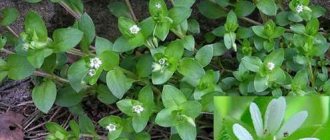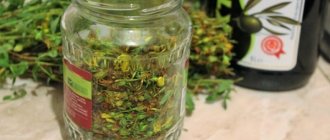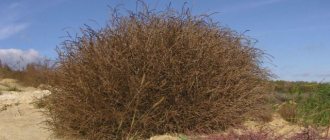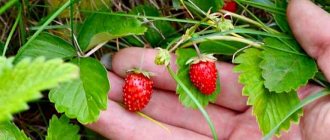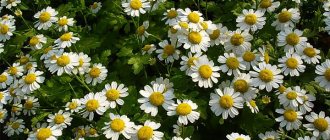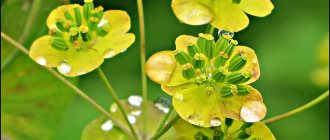Useful properties of gentian
The herb has an anthelmintic effect, so it is often included in various pharmaceutical preparations that cope with parasites. An infusion prepared from gentian is taken daily in small quantities. Within a month, the body is cleansed of helminthic infestations, as well as their waste products.
Beneficial features:
- suppresses cough;
- has a positive effect on the functioning of the gastrointestinal tract;
- stimulates appetite;
- lowers temperature;
- stimulates liver function and heart contractions;
- has an antispasmodic effect;
- has an anti-inflammatory, hemostatic and sedative effect;
- relieves cramps;
- strengthens the immune system.
The herb heals:
- constipation;
- arthritis;
- chronic hepatitis;
- diathesis;
- scurvy;
- flatulence;
- gout;
- anemia;
- jaundice;
- eye diseases;
- allergies.
Gentian is used in the treatment of the liver, gall bladder, and also as an antipyretic. In Japanese medicine, it is widely used as an antirheumatic, antifever and anthelmintic agent.
Contraindications for gentian
The herb has a wide range of beneficial qualities, but not everyone is allowed to use it. It is prohibited to use:
- pregnant women;
- nursing women;
- people with allergic manifestations.
People suffering from gastritis, high blood pressure and stomach ulcers should use the herb with caution.
It should not be used for medicinal purposes by people with high acidity, as its bitterness irritates the mucous membranes of the gastrointestinal tract.
You can grow gentian in your garden plot
What is gentian root?
Gentian root comes from flowering plants in the genus Gentian (Latin Gentiana), which includes more than 400 species native to the highlands of parts of Europe, Asia and the Americas ().
Gentian flowers come in a variety of beautiful colors, but only the root is used for medicinal purposes.
It is yellow-brown and can be dried and made into capsules, teas, tinctures and extracts. In traditional medicine, people often mix it with water and apply it externally or drink it as a drink ().
To treat swelling in the liver, spleen and stomach, people used water infused with gentian root.
They also used lotions made from gentian root and vinegar to treat skin inflammation, infected wounds and bites from poisonous animals ().
Gentian root is known for its bitter taste. In folk medicine, it is especially used as a tonic to stimulate the function of the stomach, liver and gall bladder ().
In fact, the name gentian comes from the ancient Illyrian king Gentius, who determined that the plant could be used as a tonic ().
Even today, it remains a component of alcoholic aperitifs, which are served before meals to stimulate the appetite, as well as digestifs, which are served after meals to improve digestion.
People use gentian root to make a bitter that is added to some alcoholic drinks.
Conclusion:
Gentian root comes from plants of the Gentian genus. It is used in folk medicine as a means to ease digestion and treat various diseases. Researchers continue to study its medicinal properties today.
Rules for using the herb gentian
Taking herbal tinctures and decoctions should be strictly dosed. Medicines are prepared in several ways:
- To make a decoction, pour 240 ml of boiling water into 20 g of plant material. Place on medium heat and cook for 10 minutes. After this, filter and cool. Take 20 ml three times a day.
- Infusion with alcohol. Add 50 g of dried gentian to 500 ml of alcohol (can be replaced with vodka). Cover with a lid and leave for seven days. Take a maximum of 30 drops, diluted with water, three times a day.
- To infuse with water, 80 g of herb is poured into 2 liters of boiling water. Cover with a lid and leave for 2 hours. Take 120 ml three times a day. This product can be used for compresses and foot baths.
Crossleaf gentian application
- increases appetite, normalizes digestion;
- used to enhance gastric peristalsis, improves the absorption of biologically active substances; reduces cholesterol levels;
- poisoning;
- metabolic disorders;
- lung diseases;
- disease rheumatism, gout;
- malaria;
- anthelmintic;
- heartburn;
- for treating infected wounds, eczema;
- the root of the plant prevents suppuration from developing.
Decoction
1 tsp crushed root in a glass of boiling water, keep on low heat for 10 minutes, consume a glass 3 times a day.
Gentian tincture
Pour 10g of crushed roots into a glass of vodka and leave at room temperature for 10 days. Squeeze, strain. Drink 20 drops 3 times. The properties of gentian to increase immunity and improve metabolism are irreplaceable.
Gentian herb tea
10g of gentian herb per glass of boiling water. After it sits for 20 minutes you can consume it.
Use of gentian in folk medicine
Traditional healers have long used gentian to treat tuberculosis, malaria and plague.
A decoction of the plant during flowering is taken for diseases of the nervous system, loss of strength, stomach pain and fainting. An aqueous extract of gentian is used as a hemostatic agent. An infusion of herbs and flowers is used for tuberculosis, bronchitis, throat diseases, pneumonia and as an antipyretic.
Important! The medicinal properties of the herb are used in the production of some alcoholic beverages. They are served after eating to speed up digestion.
Aqueous-alcoholic tincture exhibits anti-Trichomonas activity. As part of the collection, the infusion of flowers is used not only internally, but also topically. In Tibet, it is widely used to treat hypoacid gastritis and oral diseases.
For acute bronchitis, tonsillitis, aphonia and laryngitis, a remedy is prepared based on 300 ml of boiling water and 8 g of dry chopped grass. Leave for 2 hours, filter and take 120 ml five times a day.
Acute respiratory diseases are treated with an infusion prepared from 240 ml of boiling water and 5 g of dry chopped grass. After 1 hour, filter. Take 120 ml three times a day. In this case, the medicine must be warm. If you drink this infusion half an hour before eating, it will stimulate your appetite.
Brewed herb and gentian root help increase the body's resistance to infectious diseases and strengthen the immune system. Use during the entire treatment until ARVI completely passes. If you have a sore throat, rinse your sore throat several times a day.
Gentian decoction has a bitter taste
To improve blood flow in the body, brew gentian tea - 1 tbsp. l. the grass rhizomes are poured with 240 ml of boiling water. Boil for 5 minutes. The drink is divided into three parts and drunk before meals.
We recommend reading: Tea with thyme: beneficial properties and contraindications
A decoction of the herb and gentian root is effective in combating joint diseases of various etiologies. The natural remedy reduces inflammation, relieves pain attacks, and restores joint mobility. Decoctions are used externally in the form of compresses, lotions, and rubbing. Also used internally.
Excessive sweating - hyperhidrosis - causes great discomfort, as it is accompanied by an unpleasant odor. To reduce symptoms or get rid of the disease, special foot baths are made. A decoction prepared from 60 g of oak bark, 1 liter of boiling water and 100 g of gentian is added to the water, boiled for a quarter of an hour and left for 45 minutes.
Liver diseases are treated with an infusion prepared from 0.5 tsp. raw gentian and 400 ml of heated water. The listed components are mixed and left overnight, then filtered. It is recommended to take 100 ml four times a day before meals, half an hour before meals.
If you mix 40 g of the plant and 600 ml of alcohol, and then leave the mixture for 14 days, the resulting medicine will help in the treatment of rheumatism. Rub the infusion on the affected joints.
Gentian Types of gentians
The popular names of gentian are tirlich, heart grass, rannik, reznik, cossack, likhomannik, falcon flight. There are many types of gentians; one of the most common is yellow gentian.
Gentian Altai or grandiflora
A plant with a creeping perennial rhizome. There are many low stems up to 5 cm, with a rosette of basal leaves. The flowers of this type of gentian are large, dark blue, and grow on the tops of the stems. Grows in the Baikal region, Transbaikalia, Altai. Included in tonic, anti-sclerotic preparations.
Gentian bearded
Biennial plant. The rosette of basal leaves has large, single flowers. Grows in forest meadows, river banks, on the edges of Central Asia, Eastern and Western Siberia. It blooms from June to August, this is the time to harvest the plant's grass. The properties of gentian are used as a stomachic remedy for infectious diseases, malaria.
Gentian large-leaved or Cossack grass
A plant with a rosette of basal leaves. The perennial plant's flowers are dark blue at the top of the stem. Place of growth - Far East, Siberia. Included in products for the treatment of respiratory diseases, abscesses, and ulcers.
Gentian pulmonary or blue St. John's wort
Height up to 60cm. Several stems of the herbaceous plant are slightly branched. The leaves of the perennial plant are opposite, narrow, linear, and have one vein. The flowers are bright, dark blue, usually one at the top of the stem, or in the axils of the upper leaves. It begins to bloom in meadows, forest edges, and among bushes from July to August. Collected during flowering. Used for diseases of the nervous system, fainting, loss of strength, paralysis, stomach pain, tinnitus.
Meadow gentian
The plant is annual. The stem is straight, the leaves are ovate, the inflorescences are paniculate, lilac-violet. Grows in rare birch and deciduous forests of Western and Eastern Siberia, Altai, Krasnoyarsk Territory. Used as an antipyretic.
You may also be interested in: White mistletoe Treatment with white mistletoe
Gentian rough
Has a powerful root system. The stem of the perennial plant is round and rough, hence the name - rough. The leaves of the herbaceous plant are ovate. Blue flowers are located in the axils of the upper leaves. Place of growth: Eastern Siberia, Far East. Along with the root, the herb is used to treat malaria and as an appetite enhancer. A decoction for indigestion and gastritis. To prepare, you need 20g of herb, pour a glass of boiling water over the roots. After infusion, take from 1 to 3 tbsp. up to three times a day.
Gentian cross-leaved
A perennial herbaceous plant with a brown, thick rhizome and does not grow very tall. Its height can be from 20 cm to 70. There are several stems, they are straight with a basal rosette of leaves. Stem leaves are opposite, sessile, about 6-10 pairs. The flowers, twisted in the axils of the upper leaves, form up to six whorls. The calyx of the flower is tubular, whitish with thin membranes and a quadrangular corolla. Blooms all summer. The fruit is an elongated capsule with brown, shiny seeds. The seeds will be ripe in September-October. Gentian grows along the edges of forests, in clearings, meadows, and mountains. The place of growth is the European part of Russia, the Caucasus, Kazakhstan.
Gentian during pregnancy
Gentian is contraindicated for use by women at any stage of pregnancy. It tastes very bitter and causes nausea and vomiting. The substances contained in the herb cause an increase in the tone of the uterus.
Important! It is not recommended to use during lactation, as the plant changes the taste of milk, giving it bitterness.
Strong healing potential is hidden in all parts of the culture
Rules for collecting and storing gentian
Depending on the type, gentian can vary in height. Its flowers are most often colored purple, blue or light blue, but are also found in yellow and white shades.
All parts of the gentian herb are used for medicinal purposes: stems, flowers, leaves and roots. It blooms in July and August. Harvested at the beginning of flowering, when the leaves in the rosette have not begun to turn yellow. It is necessary to cut off the entire ground part, with or without rosette leaves. Dry in one layer in the air in the shade.
The finished raw materials can be tied into a bundle. A properly dried plant retains its natural color and bitter taste. Has no smell.
The roots are collected from early September to late October, as well as in early spring. Select specimens that have reached three years of age.
The rhizomes are dug up, thoroughly cleared of small roots, soil and above-ground parts. Wash in cold water and then cut. If the root is large in diameter, then divide it in half.
The prepared raw materials are sent to the dryer. If the temperature is above 60°C, the gentian will become deformed and its healing properties will decrease. Properly dried product has a bitter taste.
Important! If there is high humidity in the room, the raw materials will become moldy and become unsuitable for further use for medicinal purposes.
Store the preparations in a paper bag or glass jar. The place should be cool, out of direct sunlight. The maximum shelf life is five years.

